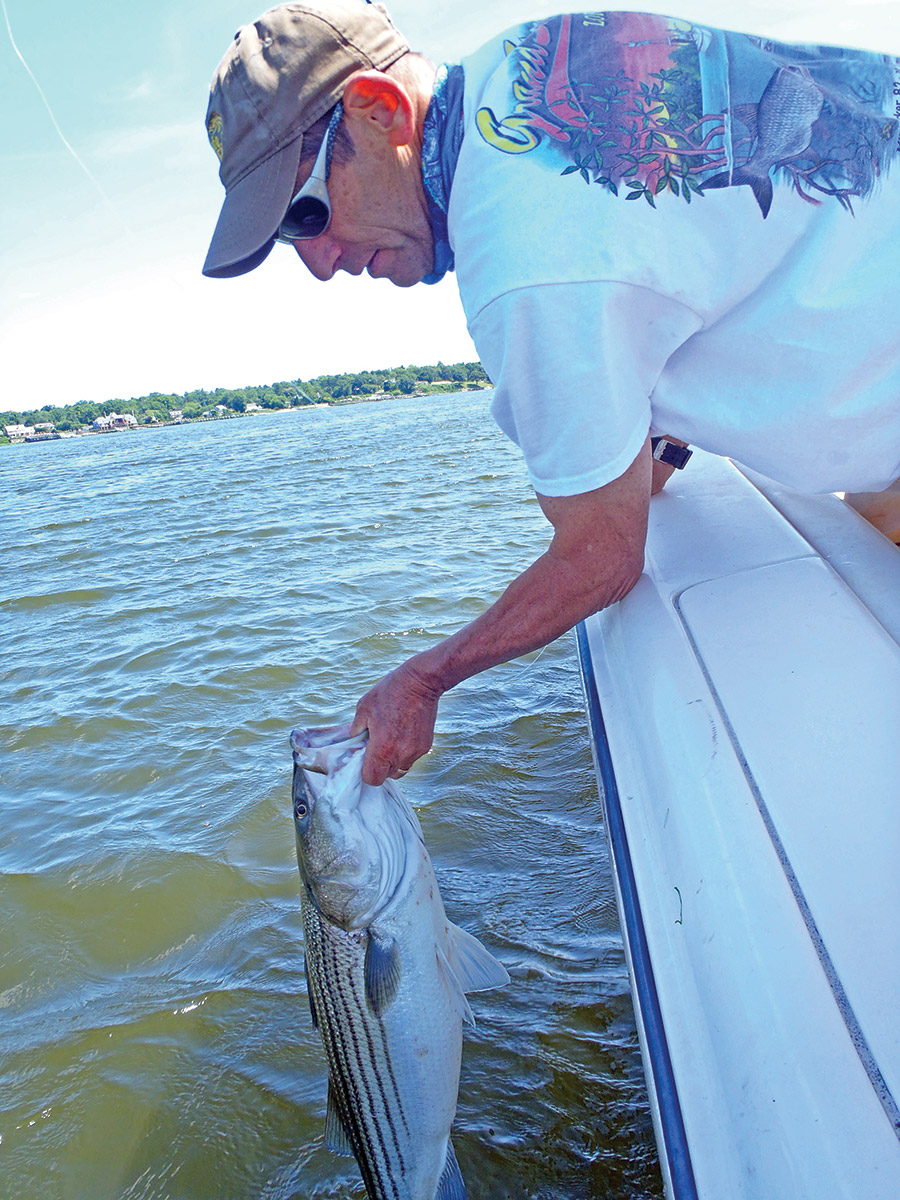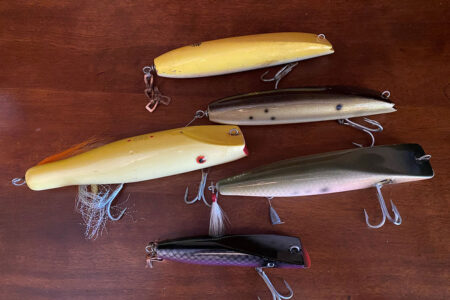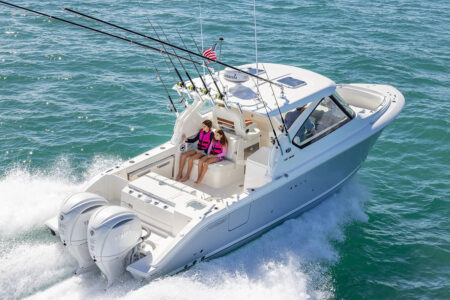
It may be a lazy delight to sit back while your bunker flops around the boat, but tending and working your gear will trigger more strikes.
If there’s one thing I’ve learned in many decades of fishing, it is that no two years are the same and no two decades are the same, either. Populations of fish wax and wane, weather patterns vary, and baitfish abundance is a flip of the coin, both in terms of amount and species. In the 1980s it was bluefish we live-lined because stripers were few and far between. In the 1990s stripers rebounded after an absence of a decade, and we discovered our techniques for blues didn’t always work well for stripers. By the way, the 1990s striper recovery shows what Nature can do if we lay off the fish for a while.
Anyway, old sea dogs needed to relearn live-lining for stripers after the moratorium, and newcomers needed information and experience. Most anglers didn’t try for stripers during the moratorium, and nuances of methodology often went forgotten. Also, striped bass recovery attracted many new anglers to fishing, but their skills needed to be developed from scratch. Suddenly, anglers needed information and a helping hand. To that end, tackle shops needed the right gear, magazines needed stories and fishing reports, and folks needed to learn how to gather live bunker.
Sadly, as the new millennium unfolded stripers began another decline and big bluefish began disappearing from the western Sound. Still, there are enough good-size bass to make live-lining worth the effort, although the approach has been updated and attention to details has become paramount. Easy live-lining is over, and it was easy in the 1990s. The recent striper decline means there are fewer anglers doing it in the estuaries. Yes, ocean live-lining has gained popularity, but this too represents a change. Indeed, until recently live-lining was basically a quiet water endeavor.
Ocean Snagging & Dropping
From mid-May and into July some years, massive schools of bunker migrate from their spawning and wintering grounds, and move up the Striper Coast with big stripers riding herd on them. The most popular technique during this time is snagging and dropping, that is snag a bunker with a large treble hook designed for that purpose and then allow it to swim until a striper finds the handicapped baitfish. Frankly, I’m not a big fan of this approach for both personal and conservation reasons. On a personal note I suffer from seasickness and find it hard to enjoy fishing while rolling about. It’s also a problem for me because it’s more like live-lining for blues in the 1980s than striper fishing in the new millennium. Let’s see if I have this right. Stripers surround a school of bunker, and then pick off the weak, sick, old, or careless. The angler snags a bunker and lets the wounded bait swim outside the bunker school. From a conservation perspective the ocean live-lining has produced a lot of big stripers that have been removed from the population and dragged back to port for photos and weigh-ins: some say too many dead big fish, and there have also been frequent reports of poaching abuses. However, there is something anglers can do to improve stewardship using the snag and drop method. How about transferring the bunker to a large circle hook and returning it to the vicinity of the bunker school? Same method, but no gut-hooked fish means stripers can be released easily and effectively.

Estuarine Live-Lining
For me, the best type of live-lining takes place in the estuary. I don’t get sick, the angler must know the lay of the land, understand the recent behavior patterns of the stripers, find and get some live bunker that are in good shape, and last but not least, set up in a good spot at the appropriate time. That’s a challenge I can respond to. Besides, in shallow water, stripers often put on more of a show because the water column is limited, encouraging a stronger fight.
In the estuary we rarely live-line for stripers near the bunker school, rather collect bunker and move to locations where stripers like to stage or ambush prey. These spots are varied and include scattered rock clusters close to shore, deeper holes, the edges of channels and bottom elevations, and eddies off any main currents. These eddies are tricky to fish because they aren’t stable: they expand and shrink, shift positions, and become weaker and stronger. Simply keeping the boat anchored in an eddy can be difficult, and keeping the bait in the feeding zone next to impossible.
Many decades ago, Rich Reina Sr. and I fished in Long Island Sound with Captain Hawkins. One of his specialties was fishing the eddies at the mouth of Huntington Harbor on the outgoing tide tight to the shore. He’d secure his anchor on the beach up-tide of a hole, and although the boat would swing a bit, it was always in one part of the eddy or another. The final piece of his solution was to add a small egg sinker to get the bunker down to the bottom where the stripers lurked. His technique worked well, and we caught quite a few big fish. One of the things I enjoyed about his style of fishing was the fish didn’t fool around with the bunker. One minute you could feel the gentle throbbing of the bunker, and then a whack, and shortly after the striper ran with the bait. I held the rod waiting for that whack with intense anticipation and excitement, and when it came, well you know. With the decline of large stripers, more fishing pressure, and, with fewer big blues I wonder whether Hawkins’s approach would still work.
In the 2000s
It may be obvious, but a clear relationship exists between abundance and success. When fish are scarce success is scarce, and inversely, when fish are abundant success is common. There’s an old adage about who catches and who doesn’t, that becomes more relevant when fish are scarce. It says 10 percent of the fishermen catch 90 percent of the fish, and 90 percent of the fishermen catch 10 percent of the fish. The disparity is the result of experience and skill. The decline of stripers makes two things important. One, we need to release more big stripers than we have in the past if we want a good body of trophy fish and second, the 90 percent need a boost in experience and skill. There are many ways to improve skill: seminars, books, magazines, hire a guide, mentoring, join a club, etc. However, there’s only one way to expand experience – go fishing and practice! Just like practicing the piano can seem like a chore, so too can practicing fishing skills, and that’s why the 90 percent often rotate back to one or two techniques and places that boost their confidence. The only way I know to get a steep learning curve is to stick with the skill you’d like to improve.
I’ve been writing, mentoring, and giving seminars for decades and with two primary objectives. One, to involve people in the sport with the hope they will become enthusiastic stewards of our living ocean resources. Second, to improve skill levels that fosters more success and because I know there is a connection between success and good stewardship.

Details
Although experience can only be gained through time, skill improvement can be accelerated. Fishing with a well-practiced live-liner will shorten the road, as will reading up on the subject. It is also possible to learn on our own by trial and error, yet skills can come slower. So, what are the skills that are keys to live-lining success in the new millennium? From my experience and observation, it boils down to details. I don’t get the chance to live-line as often as I’d like now-a-days because few of my friends do it anymore. They’ve opted for light tackle techniques instead. However, I do make trips with Rich and Marc Lazar who are experienced live-line anglers in the western Sound. We’ve had some amazing days, but many tough ones, too. Even in the glory years of the 1990s anglers didn’t catch big numbers of stripers when live-lining, and now-a-days, six or seven good fish is an extremely good day. Message: don’t expect a lot of fish, but quality is on the menu.
Structure is the key. I believe one should begin by developing an intimate knowledge of one’s backyard estuary. Depth recorders help identify structure, but there is no better way to form a clear mental picture of an estuary than to cruise around at low tide and make mental notes of all rocks, pilings, slopes, edges, etc.
Next, develop a skill and efficiency at acquiring bunker. In the golden age of big blues, we snagged and dropped, and since blues were usually on the bait quickly, the vitality of the bait was not important. Most anglers seeking stripers no longer snag in the estuary, rather master the technique of throwing a cast net. The bunkers don’t bleed out, retain vigor longer, and last longer in the livewell. Two caveats: one, don’t overload your livewell. Overloading is the key to rapid demise. The number of bunkers that can be kept alive depends on the size of the livewell and water temps, but typically we keep about eight. Yes, on some days we go through these baits quickly and it is annoying to pull anchor and collect more bait, but dead bunker aren’t as effective as lively ones. The second caution involves the water temperature. In late April through May cooler water allows us to put a few more bunker in the livewell, and they often last all day. Finally, don’t shut off your livewell circulation pump.
Working the bait is the next detail. It may be a lazy delight to sit back while your bunker flops around the boat, but tending and working your gear will trigger more strikes. To that end, the Lazars monitor the bunker, keep it at the surface, occasionally pull it back a few feet, feed some line when a striper spooks a bunker, and switch rod position as bunker swim right and left. Letting the bunker run away 5 or 10 feet engages the predator-prey response that often turns casual interest into a strike: one reason why lively baits are preferred. Unlike blues, estuarine stripers seem to be turned on by a lively bunker more than a sluggish one.
Be fastidious about your tackle. No one wants to lose a good fish because the hook is dull, the drag balks, or the line breaks. Retie, lubricate, and check tackle frequently. By the way, use monofilament for this technique. Live-lining with braid can be a nightmare. To get a good hook-up with mono, pick up any slack and when you feel line tension, inflict a serious strike to get the hook stuck in a boney maw that comes with thick cartilage.
Finally, there’s the detail of time. Don’t waste it at a spot when there is no response from stripers, and also leave when the response is repeatedly half-hearted no matter what you do. We generally use a 20-minute rule, and that relates to knowing your waters. There are lots of striper hang outs in the estuary. Work the estuary methodically from spot to spot and back again. These are just some of the details that make a difference, but they’ll get you started if you’re new to the technique, and then you can enjoy discovering other details on your own. Angling is an adventure, and part of that adventure is mastery of the challenges that you encounter.




